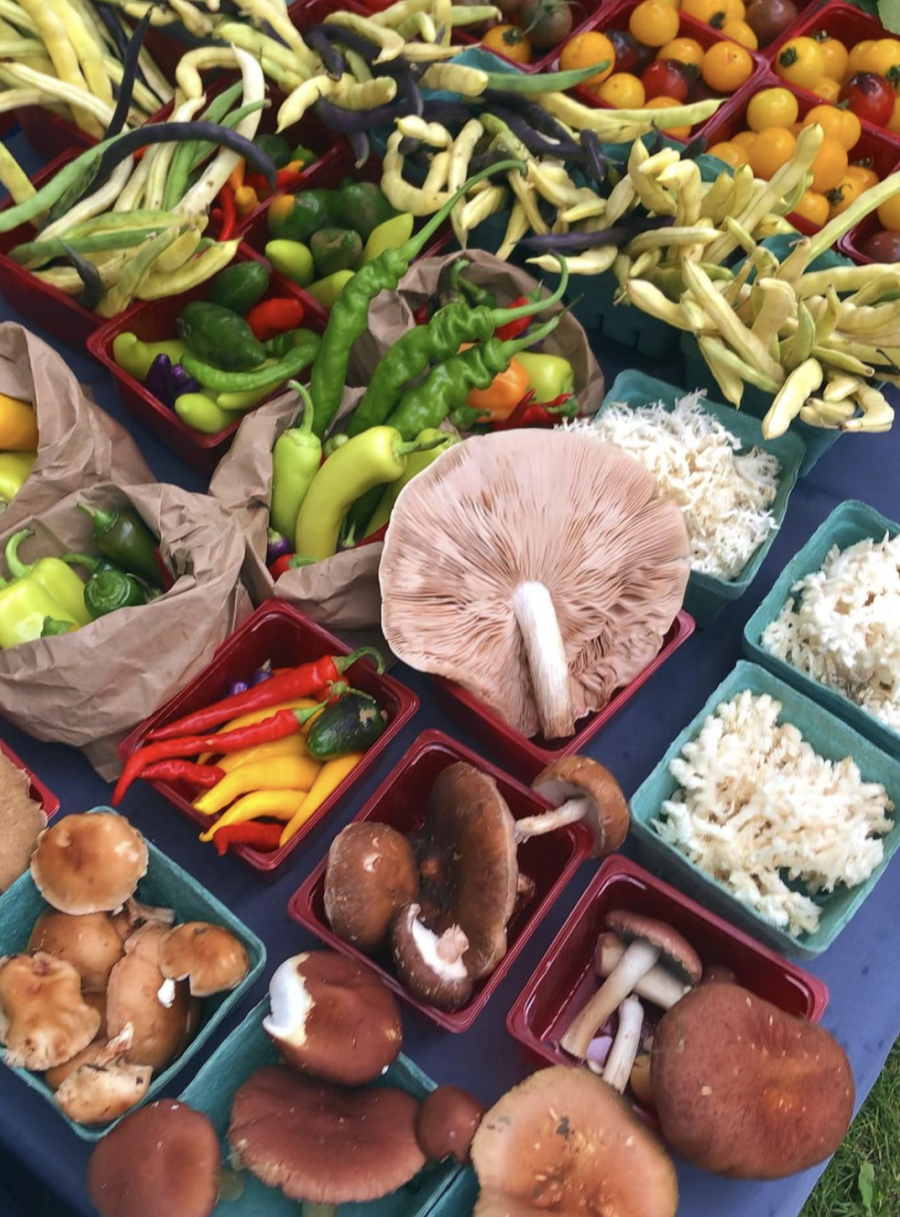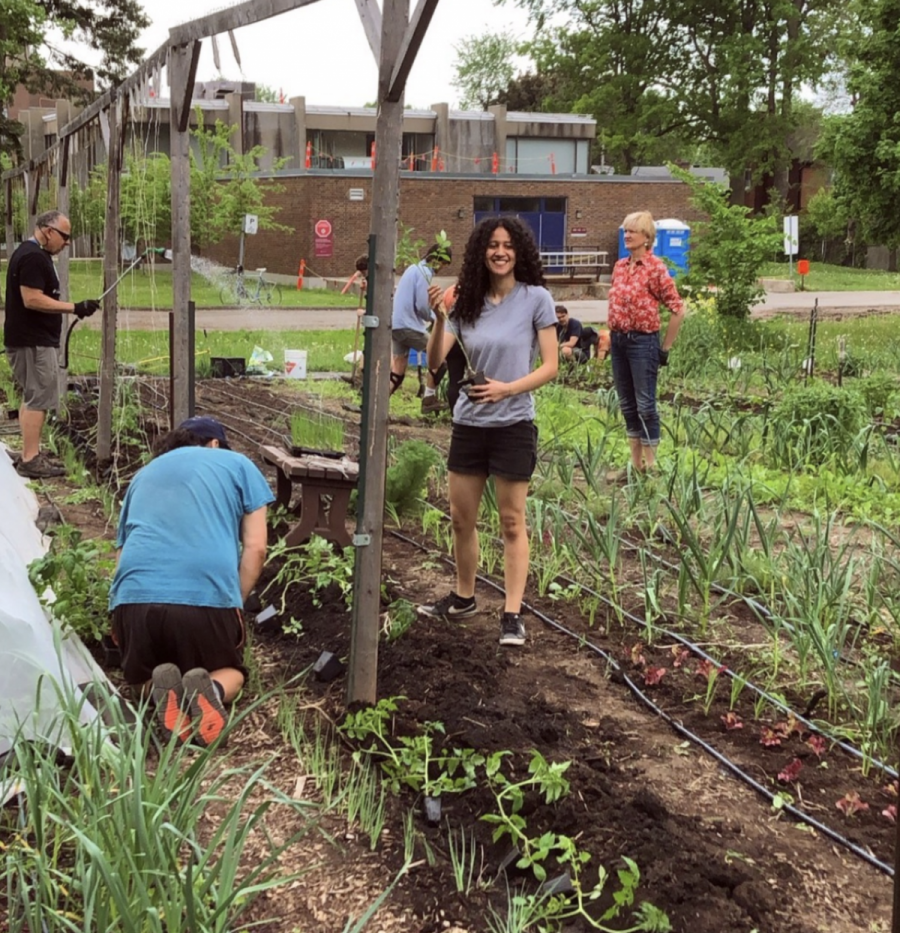Montreal’s interconnected ecosystem of community kitchens
How food groups collaborate to grow, cook and serve hot meals for free
Tucked away in Concordia University’s Loyola campus, surrounded by the monochrome of the university’s brick and concrete, is a lush expanse of green. Lettuce, radishes, kale, scallions and beets have been basking in the sun since they were planted as seedlings in May. They now peek their heads from the ground, ready to be harvested.
Caleb Woolcott, the microgreens coordinator at CultivAction, arrives at the quarter-acre farm at 6 a.m.; it is late June, the first harvest of the summer season. In a few hours, Woolcott will be joined by a team of 10 volunteers to help him and the other workers collect the produce that will be sold at the farm’s weekly pay-what-you-can market later that day.
For CultivAction, a solidarity co-operative of urban farmers, selling produce at accessible prices is a deliberate choice. The farm’s sustainably-grown ingredients seek to nourish communities in a move away from a centralized for-profit food system, Woolcott said.
“There's no owner that's, like, reaping a profit,” he said. “Community building, in that way, is the most meaningful part.”
Today, in the midst of a cost of living crisis, local organizations providing accessible food appear to be more vital than ever. CultivAction is not alone in the fight against food inflation. With grocery prices increasing, community food groups have found themselves relying on each other to continue addressing food insecurity.
“If we're trying to move away from grocery stores that pay farmers cents on the dollar, we need to figure out how to build relationships in a community food system,” Woolcott said.
Many meals served by Montreal’s community kitchens are cut from the same crop. On top of selling directly to community members, CultivAction also supplies produce to 13 different food banks and community kitchens. The morning after the farmers market, Woolcott drives around the city to donate around 135 kilograms of produce to organizations partnered with the urban farm.
But CultivAction only occupies one step in a larger network of urban farms, community kitchens, and emergency shelters. Through sharing resources, these organizations form small volunteer-driven supply chains, where everything from growing ingredients to cooking meals is done by the community.

CultivAction’s ingredients arrive in the fridges of organizations like Community Cooks Collective (CCC), which prepares and delivers meals to emergency shelters across the city. While the community kitchen also buys in bulk from big grocery stores like Costco, CultivAction’s donations help CCC maintain its ability to provide hot meals for free.
After CCC receives a delivery, volunteers use the ingredients to cook big batches of food at home. These meals are then gathered in large buckets and shipped off to be donated in bulk.
Tatiana Townsley, an organizer at CCC, said that Montreal’s community kitchens thrive off of collaboration. She said that smaller kitchens like CCC, which do not have the capacity to distribute meals directly to clients, depend on larger organizations like emergency shelters to do so. In return, CCC’s volunteers commit their time and energy to increasing the total amount of food that is distributed.
“Having community resources that provide free food or cheap, well-priced food is so important,” Townsley said. “It's a great little ecosystem.”
According to Aisha Abdunnur, a volunteer at both CultivAction and the People’s Potato, Concordia’s vegan soup kitchen, interdependence is an important aspect of the work. She believes that community members can only count on themselves to create a network capable of supporting people struggling to eat.
“Every single organization plays a part,” said Abdunnur at a community event hosted by Le Frigo Vert, a pay-what-you-can grocery store in downtown Montreal. “One of the organizations facilitates the events, the other ones literally grow the food and then some of them prepare the food.”
The strong bonds that tie together Montreal’s food groups often mean that volunteers extend their help to multiple organizations. Such is the case for Abdunnur, who offers her support across the board. She believes that, despite every organization’s distinct role, the task of fighting food insecurity is equally shared by everyone.
“All the volunteers like me are kind of passed around,” Abdunnur said. “We go to every event and every organization because at the end of the day, we need each other to facilitate everything.”
Patrick Cortbaoui, the managing director of the Margaret A. Gilliam Institute for Global Food Security, said that community kitchens have had to rely on each other in the face of Canada’s concentrated grocery industry. Loblaws, Sobeys, Metro, Walmart and Costco hold roughly 80 per cent of grocery market sales in Canada. Cortbaoui expressed that when the supply of food is held in the hands of a small number of companies, there are no barriers to stop prices from going up.
“Canadians are food insecure due to several reasons,” he said. “The main reason is not due to food availability, it's because of food inaccessibility.”
As a result, Cortbaoui said that Canadians have had to turn to community organizations to access affordable food. Community kitchens have followed suit, relying on each other to address the shortages caused by inaccessible produce.
“I’m starting to see a kind of food revolution in Canada. People are starting to think outside the box and finally realize that our food system is not sustainable,” Cortbaoui said.
The Open Door, an emergency shelter in Milton Park, is one of the organizations that CCC is partnered with. Dan Marré, the shelter’s weekend team lead, said that the shelter primarily receives its food supply from big food banks like Moisson Montréal. Despite these donations, Marré said that the support from big donors is not always enough to stock The Open Door’s fridges with the necessary ingredients to build a well-balanced menu.
“It's not like we get everything we want. Sometimes we have to get creative when preparing a menu,” he said. “For example, if we want dairy, we might get milk, we might get almond milk, we might get powdered milk.”
However, The Open Door’s relationships with smaller community kitchens help bridge the gaps in food supply that larger donors cannot fill.
Deliveries from CCC arrive at The Open Door twice a month. Ready-made meals from chili to pasta to burritos are donated to the shelter to supplement what they already offer. Marré said that The Open Door’s partnerships supply the shelter with enough food that the only ingredients they have to buy themselves are ones that are necessary for cooking, like salt and spices.
For volunteers like Abdunnur, community grown, cooked and distributed food is the most impactful way to fight against rising grocery prices. This network of interdependence, she said, is a necessary step to moving away from a for-profit food system.
“I feel whole,” Abdunnur said. “[This is] how human beings are meant to live, every action affects everyone else. We're all connected.”


_600_832_s.png)


_900_642_90_600_375_90_s_c1.jpg)

